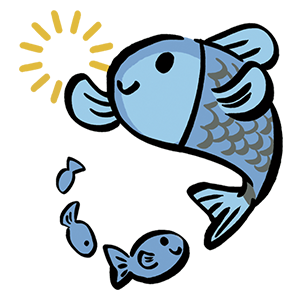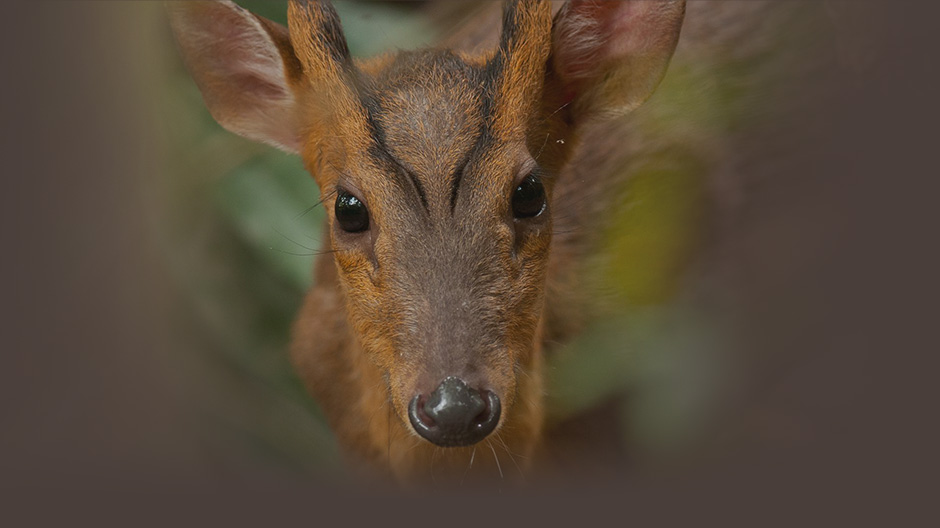1.1 What is Biodiversity?
No single organism live all alone. Any organism is related with other organisms. For example, birds live on insects as their food, some insects live on plants, and plants’ lives are sometimes supported by microorganisms. It is certain that any organisms die, and their dead bodies are decomposed by microorganisms such as fungi and bacteria. These relationships in which diverse organisms are involved, well known as food chain, or more recently recognized as food webs exist in various environment.
The range of variation of organisms is termed “biodiversity” or “biological diversity”. Biodiversity supports the lives of organisms each other, and contributes in keeping the balance in nature. In other words, biodiversity is a necessary feature of the nature. Our daily life is also supported by biodiversity.
Imagine the relationships between organisms form network-like systems. When more diverse organisms are included, the mesh formed by the relationships between the organisms become more condensed (densely connected). The complication stabilizes the system, because if one of the element (organism) die out (by e.g. extinction), the network still holds due to the complexity.
1.2 Levels of Biodiversity
Thinking more deeply about biodiversity, we recognize that biodiversity can be described in three different viewpoints.
- The first one is species diversity. This concept may be the most intuitive to understand biodiversity. It is simply understood that “there are a number of species”. The species diversity is the basis of the two other concept of biodiversity.
- The second one is termed genetic diversity referring to the genetic variation within a single species. The variety in genetic traits provides different biological characters (e.g. morphology, physiology, and behavior, etc.), which is the basis of adaptation of populations and evolution in the changing environment.
- The third one is termed ecosystem diversity, referring to the variety of ecological system where the species diversity is found. You can easily imagine the organisms in ocean are different from those in the forest. They belong to different ecosystem where different kinds of organisms form a system. However, ecosystems form a continuum having intermediate environment like rivers, lakes and brackish water bodies in between marine and forest environment.
1.3 What is Biodiversity Informatics?
To know the species biodiversity, we have to know which species occurs in where and when. Each of these facts are defined as data. In other words, data is defined as individual observation, measurements or facts referenced to some kind of accepted standards. On the other hand, information is a knowledge (product) derived from the analysis and interpretation of data. By accumulating biodiversity data, we can recognize the species diversity within a given habitat, area or ecosystem. Once the biodiversity data are cumulated, we can analyze, estimate, or compare with other data for exploitation or conservation of the biological resource. For example, we may be able to find biological resources based on the current discovery. Distribution of the species data are applicable to determine protected areas. This process is facilitated by using the techniques developed in informatics where processing, engineering and management of various information is studied (Busby, 1996). Such a field of science is referred to as biodiversity informatics. In other words, biodiversity informatics may be defined as a field of science where informatics is applied for improved management, presentation, discovery, exploration and analysis in biodiversity information.
Wikipedia Biodiversity informatics
- Reference:
- Busby JR. 1996. Management of information to support conservation decision making. In: Hawksworth, DL, Kirk, PM, and Clarke, SD (eds). Biodiversity information: Needs and Options. CAB International. Pp. 105-114.
1.4 Focus on species biodiversity
All three levels of biodiversity is important in understanding the biodiversity as a whole, but species diversity may serves the basis to understand both genetic and ecosystem diversity, because species diversity intermediates the genetic and ecosystem biodiversity. Species is also the fundamental unit in biology, and knowing which species in where and how many serves the fundamentals in ecological studies. So, in the subsequent text, we will think more deeply about species biodiversity.
By knowing the species diversity accompanied with their occurrence data, we can apply the data to conservation, human impact, invasive species, etc.
1.5 Where are the resources of biodiversity data / information?
1.5.1 Traits / Morphological description
When a new taxon (any rank of taxonomic entity, e.g. species, genus, families, etc.) is described as a species, its taxonomic characteristics is always provided. The description usually provides how the species look like, and how the species are different from other previously known species. The majority of these information is morphological, but sometimes ecological information may be included. The description includes the information about type specimen, on which the description of the species is based.
Since the description is scattered in wide range of journals and books, and descriptions are given in old literatures in most of the previously known species their accumulation is being wanted. Encyclopedia of Life (EOL) accumulates the description so that people can obtain the information regarding how the species look like.
Related Links:
- 生命大百科 Encyclopedia of Life (EOL)
- 生命大百科特徵資料庫 EOL TraitBank
- 物種形態資料庫MorphoBank
1.5.2 Taxonomy / Literature
After the first description, taxonomic revisions may be carried out. New information may be added, and their taxonomy may be revised (e.g. transfer to other genera, merged into other species, etc.). These information are provided in the literature, and should be followed to know the current position of the species or other taxon.
Literature also provides various other data. List of species in a given area or theme is usually called check list, and various checks are available. These provides the fundamental information of flora, fauna, or mycobiota previously recognized. Check list sums up a certain thematic knowledge, like endangered species, or invasive species.
1.5.3 Observation / surveys
Once the species are recognized, they become the basis to recognize the biodiversity. Going into the nature, we can obtain various biodiversity information. Imagine that you are in the forest, and recognize flowers, insects, birds, mushrooms, etc. The first step to obtain the biodiversity information may be to memorize the species you saw in the notebook. In other words, recognizing the nature by observation.
A number of bird watchers provide the result of bird survey systematically, and huge collective information has been cumulated. If we analyze these information temporally, we can assume the migration route of birds, which may help estimating the spread of the pathogen carried by birds.
While great number of data may be accumulated in relatively short period of time, the weak point for the observation data may be that they cannot be re-examined objectively.
Related Links:
1.5.4 Specimens
While observation data do not accompany with physical evidence, specimens are physical evidence that allows subsequent re-examination. When in doubt, we can always go back to the specimens, and re-examine to correct errors, if any. A number of specimen data have been digitized and stored. While specimens are the strongest evidence to support biodiversity data, collecting and keeping them may be laborious and costly. Also, collecting larger numbers of specimens are not easy compared to observation or survey.
Related Links:
1.5.5 Ecological data
Probably, one of the areas that requires biodiversity data is ecology, because a number of studies on succession of occurrence, factors that limits distribution, and biological interactions are being carried out. These studies requires a number of observations and measurements, not limited to species occurrence, but to more environmental data. For example, occurrence data of species with coordinates, tree heights with temporal data, changes of life stage with climates, temperature, precipitations, etc. A number of observation may be done by human eyes, but a number of data are now collected automatically by machines based on planned or opportunistic or serendipitous occasions. Unfortunately such data are still scattered everywhere in personal notebooks or personal computers or local servers, although data sharing for reuse have been increasingly claimed especially in the last two decades.
- Reference:
- Michener WK (2015) Ecological data sharing. Ecological Informatics 29: 33-44.
 Shortcuts
Shortcuts





